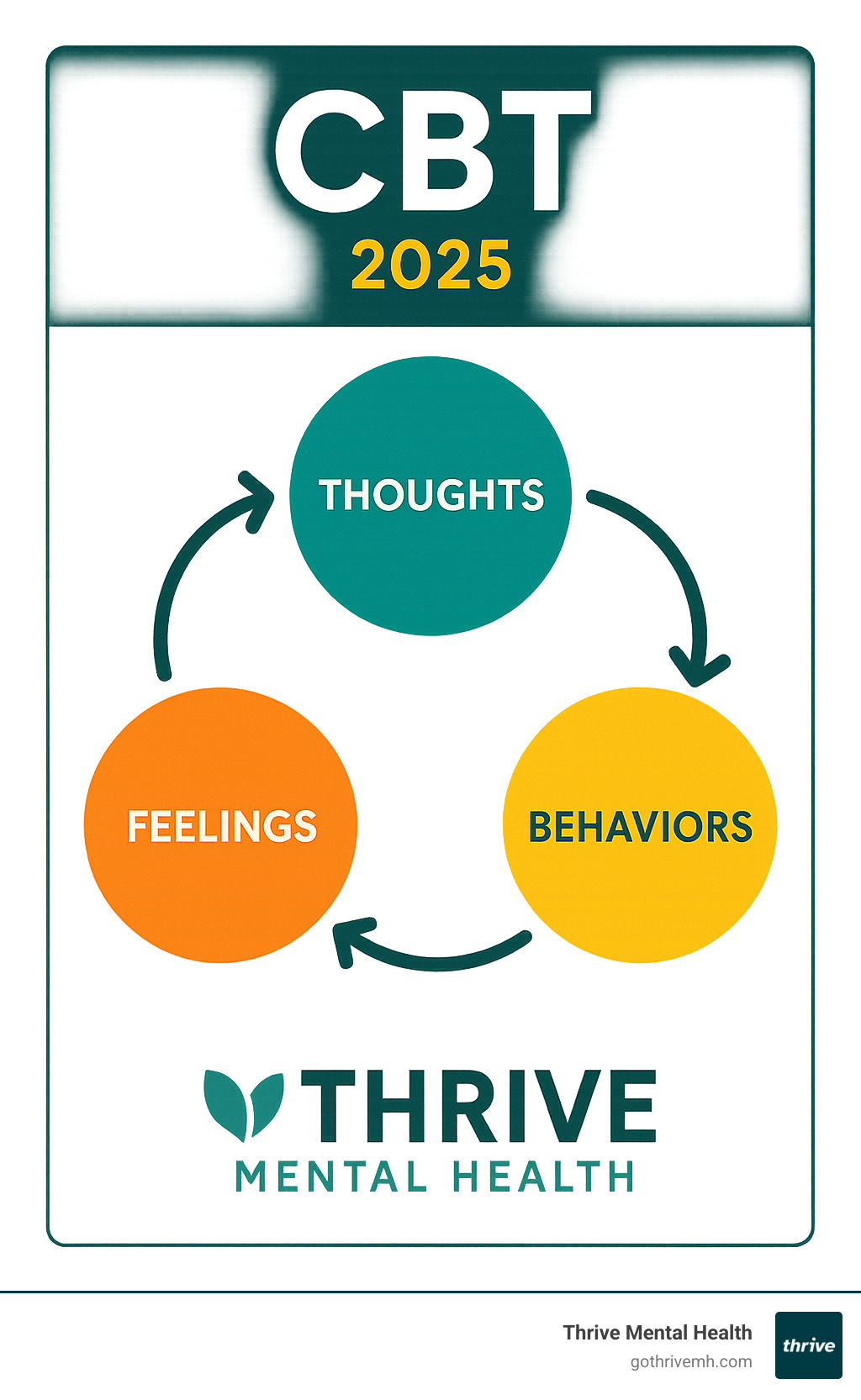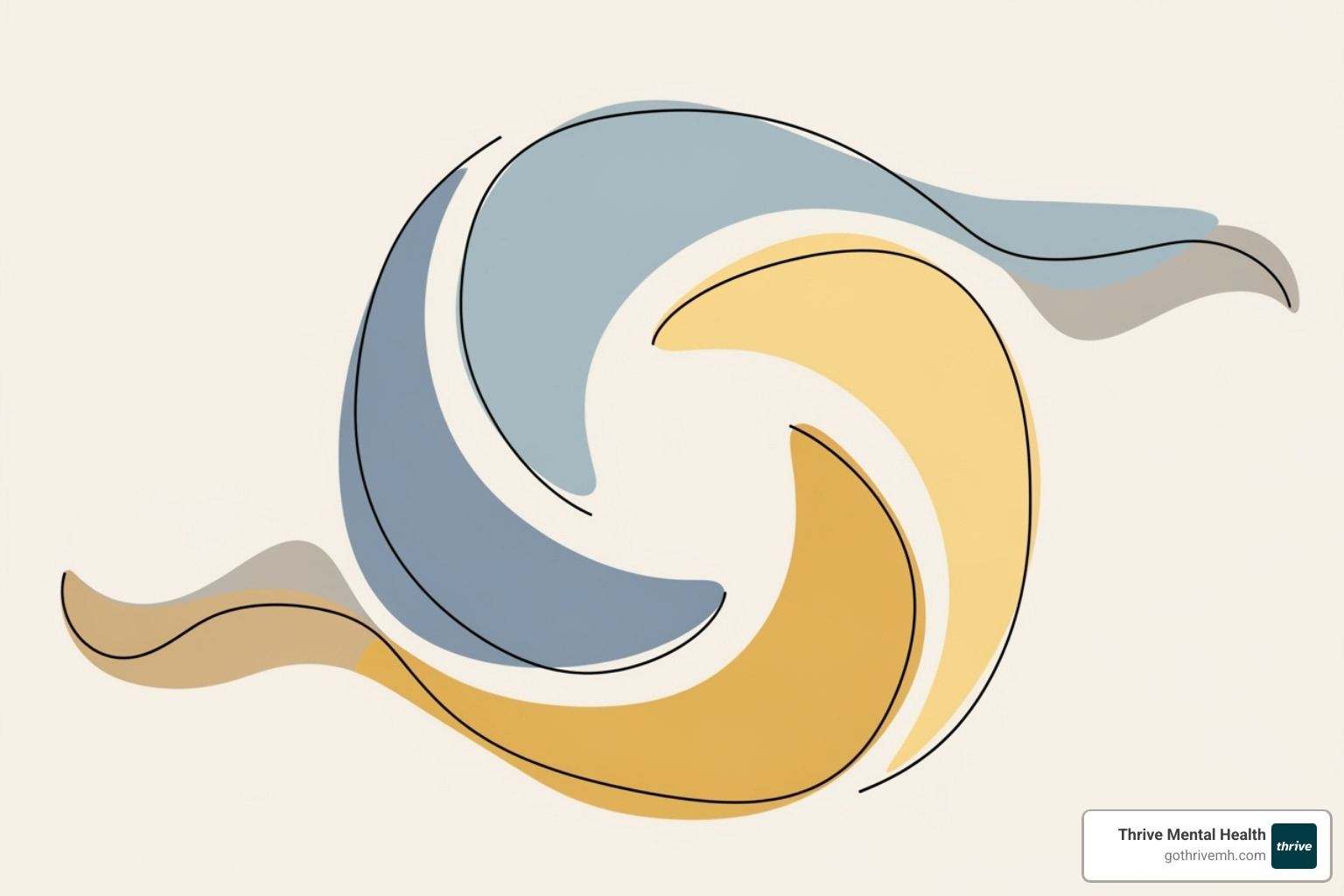Think Better, Feel Better: The CBT Guide You Didn’t Know You Needed

Why CBT Is the Mental Health Game-Changer You Need to Know About
CBT (Cognitive Behavioral Therapy) is an evidence-based psychotherapy that helps you identify and change negative thought patterns and behaviors. Here’s what you need to know:
What CBT Does:
- Connects your thoughts, feelings, and behaviors
- Teaches practical coping skills
- Focuses on present-day problems
- Provides tools you can use for life
How It Works:
- Identifies unhelpful thinking patterns
- Challenges negative thoughts with evidence
- Changes behaviors that maintain problems
- Builds problem-solving skills
What It Treats:
- Depression and anxiety disorders
- PTSD and trauma responses
- Eating disorders and substance abuse
- Chronic pain and sleep problems
If you’re a busy professional struggling with anxiety or depression, you’re not alone. Over 2,000 studies have demonstrated CBT’s effectiveness across various mental health conditions. Unlike therapies that can take years, CBT is a short-term approach, typically lasting 6-20 sessions, that gives you actionable skills for immediate use.
CBT isn’t just about talking – it’s about learning specific techniques to rewire how you think and respond to stress. The approach focuses on what’s happening right now, making it perfect for people who need practical solutions that fit demanding schedules.
As CEO of Thrive Mental Health, I’ve seen CBT transform lives by giving people concrete tools for mental wellness. My experience in behavioral health confirms that understanding the connection between your thoughts, feelings, and behaviors is the key to creating lasting change.

Quick look at cbt:
What is Cognitive Behavioral Therapy and How Does It Work?
Cognitive Behavioral Therapy (CBT) is a present-focused therapy that shows you how your thoughts, emotions, and behaviors are interconnected. It teaches you to lead this dance, rather than being swept away by it.

Developed by psychiatrist Aaron Beck in the 1960s, CBT is based on a simple idea: our feelings are determined not by events, but by our interpretation of them. Two people can face the same situation and react differently based on their thoughts.
What makes CBT different is its collaborative process. You and your therapist work as a team, using a problem-solving approach to give you real tools for real life. This isn’t about endlessly discussing your childhood – it’s about building skills you can use today and for years to come.
The beauty of CBT is that it turns you into your own therapist. You learn to catch negative thoughts, question them, and replace them with more balanced thinking. Want to see the science behind this? Check out this scientific research on how CBT works.
The Core Principles of CBT
Understanding CBT starts with a few key ideas. The interconnection of thoughts, emotions, and behaviors forms the foundation – when one changes, the others follow.
We all get stuck in unhelpful thinking patterns, like catastrophizing or all-or-nothing thinking. These patterns feel automatic, but they’re actually learned behaviors – which means they can be unlearned.
What sets CBT apart is its goal-oriented nature. From your first session, you’ll work with your therapist to set specific, achievable goals, moving you closer to where you want to be.
How CBT Helps You Change
The change process in CBT happens through practical steps. First, you’ll learn to identify negative thoughts – those automatic reactions that pop up before you realize it.
Next comes challenging cognitive distortions. Your therapist will teach you to fact-check your thoughts by asking questions like, “What’s the evidence for this thought?” This isn’t about forced positivity; it’s about realistic thinking.
Developing coping skills is the practical heart of CBT. You’ll build a personalized toolkit of strategies for managing difficult emotions and solving problems.
Behavioral change often creates the most dramatic shifts. Sometimes changing what you do is the fastest way to change how you feel. This might involve gradually facing fears or scheduling enjoyable activities.
The ultimate goal is becoming your own therapist. By the end of your CBT journey, you’ll have internalized these skills so you can spot and challenge unhelpful patterns on your own.
Common Techniques and Strategies Used in CBT
What makes CBT so effective is its hands-on approach. It’s about learning real skills you can use every day. Think of it like learning to drive: you need both theory and practice.

Your therapist will give you “homework” between sessions to practice what you’re learning in real-world situations. This might include keeping a thought diary or trying a new coping strategy. This practical application is what makes the changes stick.
CBT uses two main types of techniques: cognitive techniques to change unhelpful thinking, and behavioral techniques to change what you do. Both work together to create lasting change.
The beauty of these techniques is that they’re practical and portable. Once you learn them, they become part of your mental health toolkit for life.
Cognitive Techniques in a CBT Session
In a CBT session, you’ll focus on reshaping how you think. Your therapist might ask about a recent upsetting situation, then guide you through examining your thoughts about it.
Cognitive restructuring is a core technique. For example, if you think “I’m terrible at my job” after a mistake, your therapist helps you examine the evidence. Together, you’ll develop a more balanced thought like “I made a mistake, but I’m still a competent employee.”
Thought records are worksheets that guide you through this process. You’ll write down the situation, your automatic thoughts, and then work on challenging them.
Your therapist will also help you spot cognitive distortions – common thinking traps like “mind reading” (assuming you know what others think) or “catastrophizing” (jumping to the worst outcome).
Socratic questioning is another powerful tool. Instead of giving advice, your therapist asks questions like “Is there another way to look at this?” to help you find your own insights.
Behavioral Techniques in a CBT Session
Sometimes the fastest way to feel better is to change what you’re doing. CBT recognizes that our actions have a huge impact on our emotions.
Behavioral activation is especially helpful for depression. It involves scheduling meaningful or enjoyable activities, even when you don’t feel like it. The idea is that action leads to motivation, not the other way around.
Exposure therapy is highly effective for anxiety. You’ll gradually face your fears in a controlled way, starting with small steps to build confidence and show your brain the situation isn’t as dangerous as it seems.
Activity scheduling helps add a balanced structure to your days, including work, rest, and enjoyable activities, which is especially helpful when motivation is low.
Relaxation techniques like deep breathing or progressive muscle relaxation give you immediate tools to manage stress. They calm your body’s stress response, creating space for clearer thinking.
Role-playing provides a safe space to practice difficult conversations or social situations, like setting a boundary with a boss, before you try it in real life.
Conditions Treated and The Proven Effectiveness of CBT
What makes CBT remarkable is the breadth of conditions it helps and the mountain of research backing it up. I’ve seen CBT deliver consistent results across many different mental health challenges.

The beauty of CBT is its adaptability. Whether you’re a young professional with anxiety or someone managing chronic pain, the core principles are customized to your needs. This flexibility is why healthcare systems consider CBT the gold standard of psychotherapy.
What truly sets CBT apart is its focus on teaching you skills that last. You’re not just getting better for now – you’re building a toolkit to stay better long after therapy ends.
What CBT Can Help With
CBT can address a surprising range of conditions. Here are some common areas where it makes a real difference:
- Depression: CBT directly tackles negative thought patterns and uses behavioral activation to help you re-engage with life.
- Anxiety Disorders: For generalized anxiety, panic disorder, or phobias, CBT helps you face fears gradually and challenge catastrophic thinking.
- PTSD: Trauma-focused CBT provides a safe way to process traumatic memories and reclaim your sense of safety.
- OCD: A specialized form of CBT called Exposure and Response Prevention is highly effective at breaking the cycle of obsessions and compulsions.
- Eating Disorders: CBT addresses distorted thinking about food and body image while helping develop healthier coping strategies.
- Insomnia: CBT for insomnia (CBT-I) is often more effective than sleeping pills at addressing the thoughts and behaviors that disrupt sleep.
- Substance Use Disorders: CBT helps identify triggers, develop coping mechanisms, and challenge thoughts that lead to relapse.
- Chronic Pain: While it doesn’t cure physical pain, CBT reduces the emotional suffering that often accompanies it, helping you live well despite the pain.
What the Research Says
Here’s where CBT really shines: the research is staggering. Over 2,000 studies consistently show its effectiveness, which is unprecedented in the therapy world.
The efficacy rates are remarkable. For many conditions, CBT performs as well as or better than medication. When combined with medication, the results often surpass what either treatment can achieve alone.
What’s most exciting is the long-term benefits. CBT gives you skills that keep working years later. Studies show that people who complete CBT are less likely to relapse because they’ve learned to be their own therapist.
The research on anxiety is particularly compelling. A comprehensive meta-analysis on CBT for anxiety disorders found significant improvements across the board.
At Thrive Mental Health, we’ve seen these research findings play out with our clients in Florida. The combination of CBT principles with our flexible programs creates an environment where lasting change isn’t just possible – it’s expected.
What to Expect From Your CBT Journey
Starting your CBT journey is like learning a new, life-long skill. It’s normal to feel nervous, but think of it as partnering with a guide who will help you steer your thoughts and feelings in new, positive directions.
What makes CBT different is its focus on the here and now. While we might explore how past experiences shaped current patterns, we spend most of our time on what’s happening in your life today. You’re an active participant in your own healing, setting agendas and tackling challenges as a team.
The Structure and Duration of Treatment
Here’s the good news for busy professionals in Florida: CBT is designed to be efficient. You won’t be in therapy for years wondering when you’ll see results.
Most people complete their CBT journey in 6 to 20 sessions. A specific anxiety might take 6-8 sessions, while more complex challenges might take closer to 20. This is still relatively short-term compared to other approaches.
We typically meet weekly for about 60 minutes. This regular schedule helps you build momentum. Each session starts with a check-in, and then we set an agenda together to ensure we use our time wisely.
Between sessions, you’ll have homework assignments – practical exercises designed to help you apply what you’re learning. This is where the real magic happens, as you start using your new skills in everyday life.
Benefits and Potential Challenges
The benefits of CBT extend far beyond feeling better. You’re gaining empowerment over your mental wellness. Instead of feeling controlled by your emotions, you learn to influence your internal experience.
The practical life skills you develop show up in your relationships, your work, and how you handle stress. Many of our clients at Thrive Mental Health find these skills improve areas of their lives they weren’t even focusing on in therapy.
Perhaps most importantly, CBT creates lasting change. Because you learn to be your own therapist, you’re equipped to handle future challenges long-term.
Now, let’s be honest about the challenges. CBT requires effort and commitment. You’ll need to engage actively and complete homework assignments.
Some aspects can be emotionally challenging. Examining long-held beliefs or facing fears can be uncomfortable, but it’s a sign of growth. We’ll support you through it.
Progress in CBT is typically gradual. You’re building new mental habits, which takes time and practice. Some weeks will feel like huge strides, while others might feel slower. That’s a normal part of the process.
How to Find a Qualified CBT Therapist in Florida
Finding the right therapist is one of the most important steps you’ll take. Here in Florida, where life moves fast, having access to quality CBT care makes all the difference. Whether you’re in Tampa Bay, Orlando, Miami, or elsewhere in the Sunshine State, excellent CBT therapists are available both in-person and virtually.

The key is knowing what to look for. Not all therapists are trained in CBT, so you want someone with specific training and experience relevant to your situation.
At Thrive Mental Health, we’ve made this process easier by building CBT into our intensive outpatient and partial hospitalization programs. Our licensed professionals use evidence-based CBT techniques as a cornerstone of treatment, available virtually or in person across Florida.
Questions to Ask a Potential Therapist
When considering a therapist, think of it as an interview. Don’t be shy about asking questions; a qualified professional will welcome them.
- Ask about their CBT credentials. Do they have specialized training or certification in CBT? This ensures they understand its nuances.
- Get specific about your concerns. Ask about their experience treating your specific issue, whether it’s anxiety, depression, or something else.
- Understand their approach. Ask what a typical session looks like. How is it structured? Do they assign homework? This gives you a real sense of what to expect.
- Talk money upfront. Ask about their fees, whether they accept your insurance, and if they offer payment plans. At Thrive Mental Health, we work with you to understand your benefits and explore options.
Where to Look for Help
Finding a qualified CBT therapist has never been easier, especially with the growth of virtual therapy options that serve all of Florida.
- Your doctor is a great starting point. Primary care physicians often have referrals to trusted mental health professionals.
- Your insurance company can be helpful. Most providers have directories of in-network professionals. Just remember to verify that they specifically offer CBT.
- Professional organizations can be a resource. Reputable organizations for cognitive behavioral therapy often have resources for finding qualified professionals. These can help you search by location and specialty, but always verify a therapist’s credentials independently.
- Consider intensive programs like ours at Thrive Mental Health. Sometimes, more intensive support is needed. Our intensive outpatient and partial hospitalization programs integrate CBT with other treatments, giving you comprehensive care that fits your schedule. Our virtual options make expert-led CBT accessible from your home or office anywhere in Florida.
The bottom line: don’t settle. CBT is a specialized skill, and you deserve someone who knows how to use it effectively. Take your time, ask questions, and trust your instincts.
Take Control of Your Mental Wellness
This guide has shown you that CBT isn’t just another therapy approach—it’s a roadmap to lasting change. When you understand how your thoughts, feelings, and behaviors connect, you gain the power to reshape your mental wellness from the inside out.
Every challenge becomes an opportunity to practice the skills CBT teaches. An overwhelming work presentation? You’ll know how to challenge catastrophic thoughts. A relationship conflict? You’ll have tools to examine your thinking and respond more effectively.
CBT empowers you to become your own therapist, equipped with practical skills that work in real life. The research backs this up—over 2,000 studies show that people who learn these techniques maintain their progress long after therapy ends.
At Thrive Mental Health, we’ve built our programs around this evidence-based approach because we’ve seen how transformative it is. Our intensive outpatient (IOP) and partial hospitalization (PHP) programs integrate CBT principles into flexible care that fits your busy life. Whether you’re a professional in Tampa dealing with anxiety or someone in Central Florida managing depression, our expert-led programs are designed to meet you where you are.
The beauty of our approach is its accessibility. You can access the same high-quality care whether you prefer virtual sessions or in-person support. Geography shouldn’t limit your access to life-changing mental health care.
It’s time to stop letting unhelpful thought patterns run the show. You have the power to think more clearly, feel more balanced, and live more fully. CBT gives you the tools—we’re here to guide you in using them.
Ready to take that next step? Learn more about our flexible IOP and PHP programs and find out how our evidence-based approach can help you build the resilient, fulfilling life you deserve.

One thought on “Think Better, Feel Better: The CBT Guide You Didn’t Know You Needed”
Comments are closed.